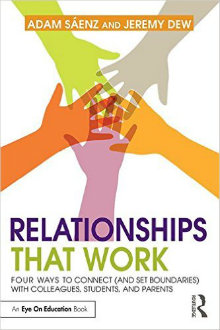Building Relationships That Work at School
Relationships That Work: Four Ways to Connect (and Set Boundaries) with Colleagues, Students and Parents
By Adam Sáenz and Jeremy Dew
(Routledge/Eye on Education, 2015 – Learn more)
 Reviewed by Laura Von Staden
Reviewed by Laura Von Staden
Adam Sáenz starts this book not by telling us why relationships are important, but by showing us through his own story as a student on two different campuses.
He and co-author Jeremy Dew then spend the next chapter describing healthy and unhealthy relationships. They define four key questions/components we must consider if we want to build healthy relationships that serve us well:
Reflecting: Why am I here?
Directing: Can I manage my emotions?
Connecting: Can I build a bridge?
Protecting: Can I build a fence?
 I expected a book with a title like this to spend a lot of pages describing all the things I needed to do and not to do in order to build relationships. While this book does have that information, it is presented in a much more user-centered format.
I expected a book with a title like this to spend a lot of pages describing all the things I needed to do and not to do in order to build relationships. While this book does have that information, it is presented in a much more user-centered format.
What you’ll learn
Sáenz and Dew start with reflecting and identifying our calling, and make the argument that if we have the right “why,” we will be able to persist through the tough days and expend the time and energy required to build relationships that will help move us toward fulfilling our personal and professional goals.
The authors include a sentence completion activity to help guide us in identifying our calling, which is quite useful, as well as a two-sentence completion activity to create a personal mission statement: “I am an educator because . . .” (the right why) and “Because I am an educator . . .” (the future impact that you want to achieve) (p. 49).
They round out this chapter the way they do each of the main chapters, with a section on how reflecting on your calling impacts relationships, followed by a summary of key points.
Directing, connecting and protecting
In the Directing chapter the authors address emotions and the energy associated with them. The activity in this chapter is aimed at helping us shift from automatic responses to our “triggers” – most of which originated in our childhood – to identifying these feelings, creating a new thought pattern, and thus becoming able to produce a mindful response.
The other two main chapters focus on activities to help us think about finding common ground and building bridges (Connecting chapter); and on protecting ourselves by building necessary fences (Protecting chapter), something teachers seem to struggle with. The authors emphasize the importance of setting boundaries and having balance in our lives so that we do not become less able to be effective in our jobs and ultimately damage the relationships that we have been trying to build.
Each chapter has an activity to complete to help us with the question of the chapter; a story of a teacher with reference to the area being discussed; a short section on how the topic impacts our relationships, and a box with the key summary points.
This book provided a different approach to my learning about creating healthy relationships. It wasn’t what I anticipated – it proved to be more enjoyable and interactive with the activities and stories provided.
Definitely worth the read.
Dr. Laura Von Staden is a Middle School Special Education Lead Teacher in Tampa, Florida. She serves on numerous committees both at her school and within her district and works closely with the local university where she is a Professional Practice Partner and a master mentor. Dr. Von Staden also facilitates both online and face-to-face Professional Development for her school district.

































